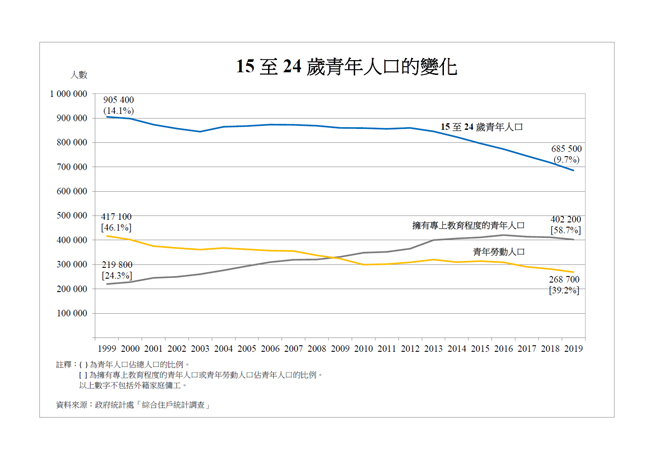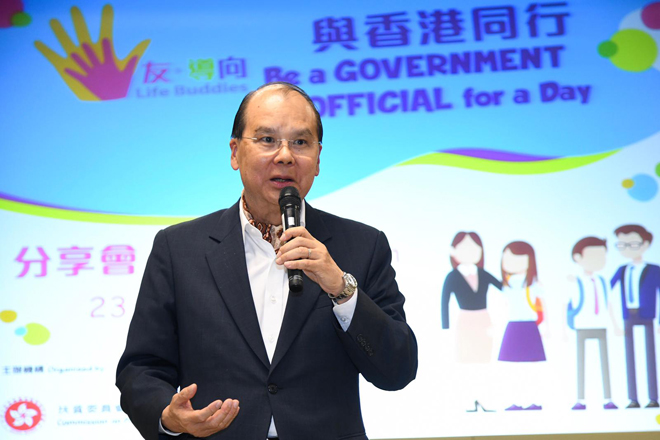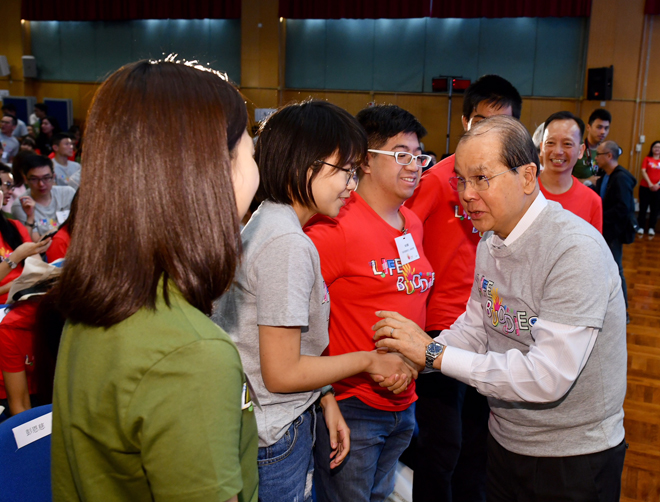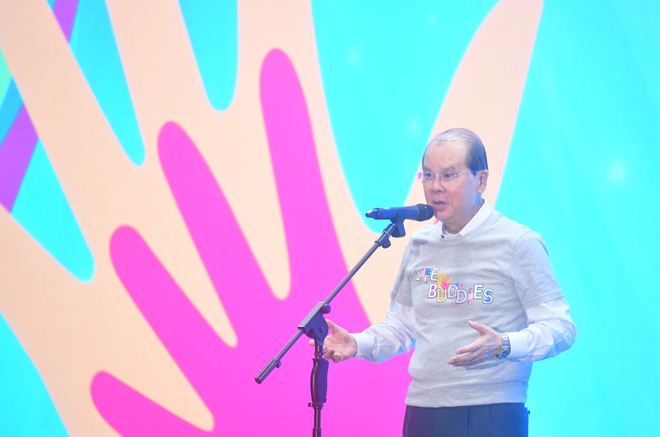Nurture our youths and invest for the future
(10 May 2020)

|

|

|

|
The May Fourth Youth Day has just passed. Last Monday, I posted a message on a social networking website, advising young people to continually reflect upon themselves, seek new knowledge and make contributions to society. Young people are the hope and future of society as well as the engine of long-term socio-economic development. However, owing to an ageing population and a persistently low fertility rate, our youth population and youth labour force have been shrinking in recent years.
Under such demographic changes, every single youngster counts. Opportunities for local tertiary education have been increasing incessantly. Youth education and development have become all the more important. As the saying goes, “Today’s Seeds, Tomorrow’s Harvest”.
From 1999 to 2019, the youth population between the ages of 15 and 24 reduced by 219 900, a decrease of 1.4% per annum on average. In 2019, the youth population was 685 500, accounting for only 9.7% of the total population, which was far lower than the 14.1% in 1999.
In the past two decades, the size and proportion of the youth population with post-secondary education (including those still studying; the same applies hereinafter) increased notably, meaning that the younger generation has a higher education level compared to the older generation. Young people with post-secondary education increased significantly from 219 800 in 1999 (accounting for 24.3% of the youth population) to 402 200 in 2019 (accounting for 58.7% of the youth population). Among the entire youth population, the proportion with education at first degree level increased almost two-fold from 13.2% to 38.6%, while the proportion with education at postgraduate level had a six-fold increase from 0.5% to 3.1%.
Young people have been joining the labour market at a later age by virtue of increasing educational opportunities. This, coupled with a declining youth population over the past two decades, caused the number of working youths to drop from 417 100 in 1999 to 268 700 in 20191. It was projected2 that the number would plunge in the coming few years to a low of 223 600 in 2025 and then bounce back, before gradually decrease again. From 2050 to 2066, the number of working youths would be around 210 000 to 230 000.
Global competition is fierce. In light of a shrinking labour force resulting from the ageing population, it is increasingly important to upgrade our human capital in order to enhance our competitiveness and productivity as well as continue our development towards a higher value-added and more knowledge-based economy. A well-educated workforce is essential for Hong Kong to meet the keen demand for talent. Notwithstanding the decline in the youth population, the Government will continue to devote more resources to nurturing talent and creating favourable conditions for youth upward mobility.
The total expenditure on education for 2020-21 is $112.3 billion. Of this, the recurrent expenditure has increased by 7.8% to $99.6 billion, accounting for over 20% of the total government recurrent expenditure and taking up the largest share among all policy areas. The recurrent expenditure on education has increased by nearly 80% within ten years (i.e. from 2011-12 to 2020-21).
Despite the drop in the number of candidates sitting for the Hong Kong Diploma in Secondary Education Examination (DSE) in recent years, the number of undergraduate places have not reduced. There are over 50 000 DSE takers this year and a total of about 52 000 full-time locally accredited post-secondary places, including some 23 000 undergraduate places and 29 000 sub-degree places, are provided. The number of publicly-funded and self-financing first-year first-degree places is sufficient to meet the demand from all Form 6 students meeting the minimum entrance requirements for undergraduate programmes.
In addition to academic education, the Government is committed to promoting vocational and professional education and training (VPET). To enhance the quality and learning experience of VPET programmes, the Training and Support Scheme implemented by the Vocational Training Council has been regularised from the 2019/20 academic year onwards. With increases in the number of places and the amount of allowance provided under the Scheme, more trainees may receive apprenticeship training under an “Earn and Learn” model to attain recognised qualifications. In future, the Government will subsidise trainees to attend study and exchange programmes outside Hong Kong to broaden their horizons. The Government will also enhance and deepen its cooperation with various trades to encourage more young people to make VPET their first choice.
Regarding life planning education, the Government, besides providing schools with the Career and Life Planning Grant and additional manpower, has enhanced professional training for teachers. Also, diversified career exploration activities are provided for students through the Business-School Partnership Programme.
In Hong Kong, both economic activities and the labour market have suffered an unprecedented blow under the epidemic. In the first quarter of this year, the unemployment rate soared by 0.5 percentage point to 4.2% while the underemployment rate surged by 0.6 percentage point to 2.1%, both being the highest in nearly a decade. Amid the economic recession, young people seeking employment will invariably face severe challenges. I believe that many of them, particularly fresh graduates, are worried about their employment prospects. In this regard, the Government has launched massive relief measures under the Anti-epidemic Fund, including those for job retention and creation, which also cater for youth employment needs.
In the coming two years, the Government will invest $6 billion to create around 30 000 time-limited jobs in the public and private sectors for people of different skill sets and academic qualifications. Also, the Government will recruit over 10 000 civil servants and offer about 5 000 short-term intern positions this year.
Youth employment will be one of the Government’s future policy priorities. The Youth Development Commission (YDC) chaired by me is about to meet for focused discussion on initiatives to promote youth employment. Through the platform of the YDC, I will foster cross-bureau and cross-sector collaboration to make the various job retention and creation initiatives more befitting to people’s needs.
The YDC will also make use of multiple channels to strengthen interaction with young people from different social strata, listen to their views on issues such as employment and education, and gauge the pulse of the younger generation so that the Government’s policies will incorporate their opinions and suggestions, thereby engaging them in building a better Hong Kong.
Depending on the development of the epidemic, the YDC will continue to take forward projects that can support young people in pursuing innovation and entrepreneurship and engaging in exchange, internship and life planning activities to better equip themselves. Opportunities come to those who are ready. Young people who do not seize any opportunity will forego the chance of showcasing their talent and unleashing their potential.
At a time when the risk of violence is simmering, some young people who are immature and have limited life experiences may be easily incited to commit crimes and fall prey to vices. This is worrying indeed. These youngsters may not know the serious consequences of breaking the law, and their future is at stake. The community is in need of righteousness to curb the evil trend of violence. My advice to young people is to keep their noses clean and cherish what lies ahead.
A nation will prosper only when its young people thrive, and be strong only when its young people are strong. The Government of the Hong Kong Special Administrative Region is committed to nurturing the younger generation into citizens who have a positive outlook on life, are socially responsible and law-abiding, and possess a sense of national identity, a love for Hong Kong as well as an international perspective.
Turning to the Legislative Council (LegCo), I am pleased to learn that after business had been brought to a standstill for seven months since last October owing to the delay in chairman election, the impasse in the House Committee finally ended two days ago. The operation of this important part of the LegCo has resumed, which enables the continual scrutiny of bills and subsidiary legislation proposed by the Government, including a number of bills that are closely related to socio-economic development and people’s livelihood. The Government will continue to fully co-operate with LegCo with regard to the scrutiny of bills in its remaining term of office. As we cannot afford more internal conflicts, the resumption of operation of the House Committee, which is gradually getting back on track, is beneficial to the well-being of Hong Kong as a whole.

